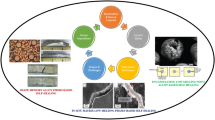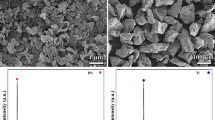Abstract
A superelastic Ti–40Nb alloy enhanced with Cu element (0, 2.5, 5, 7.5, and 10 wt%) was synthesized by a spark plasma sintering method to obtain biomaterials with an antimicrobial effect. The microstructure results showed that β phase was the main phase in (Ti–40Nb)–Cu alloys while Ti2Cu was synthesized with the Cu addition above 5 wt%. (Ti–40Nb)–Cu alloys exhibited high compressive strength over 1693.08 MPa, high yield strength of 1140.26–1619.14 MPa, low elastic modulus in the range of 43.91–58.01 GPa, low elastic energy (14.81–24.73 MJ/m3), and together with large plastic strain over 18.5%. High concentration of Cu ion released steadily from alloys in early 7 days, then the released concentration of Cu ion showed long-lasting and moderate. Comparing with the Ti–40Nb alloy, high antimicrobial activity was pronounced on (Ti–40Nb)–Cu alloys, and (Ti–40Nb)–Cu alloys showed more inhibitory activity against bacteria (E. coli and S. aureus) than fungi (C. albicans). Cu contents in alloys influenced the Cu ion release, which in turn affected the antimicrobial activity. As a good combination of low elastic modulus, high mechanical properties, good elastic energy, and excellent antimicrobial performance, (Ti–40Nb)–Cu alloys offer potential advantages to prevent stress shielding and exhibit an excellent antimicrobial property for hard tissue replacements.







Similar content being viewed by others
References
Q.Z. Chen and G.A. Thouas: Metallic implant biomaterials. Mater. Sci. Eng., R 87, 1–57 (2015).
Y.L. Hao, S.J. Li, S.Y. Sun, C.Y. Zheng, and R. Yang: Elastic deformation behaviour of Ti–24Nb–4Zr–7.9Sn for biomedical applications. Acta Biomater. 3, 277–286 (2007).
H. Baker, H. Okamoto, and S.D. Henry: ASM Handbook: Alloy Phase Diagrams, Vol. 3 (ASM International Materials Park, Ohio, 1992).
J. Fu, A. Yamamoto, H.Y. Kim, H. Hosoda, and S. Miyazaki: Novel Ti-base superelastic alloys with large recovery strain and excellent biocompatibility. Acta Biomater. 17, 56–67 (2015).
S. Miyazaki, H.Y. Kim, and H. Hosoda: Development and characterization of Ni-free Ti-base shape memory and superelastic alloys. Mater. Sci. Eng., A 438, 18–24 (2006).
W.H. Harris and C.B. Sledge: Total hip and total knee replacement. N. Engl. J. Med. 323, 725–731 (1990).
F. Heidenau, W. Mittelmeier, R. Detsch, M. Haenle, F. Stenzel, G. Ziegler, and H.A. Gollwitzer: A novel antibacterial titania coating: Metal ion toxicity and in vitro surface colonization. J. Mater. Sci.: Mater. Med. 16, 883–888 (2005).
H. Waizy, J.M. Seitz, J. Reifenrath, A. Weizbauer, F.W. Bach, A. Meyer-Lindenberg, B. Denkena, and H. Windhagen: Biodegradable magnesium implants for orthopedic applications. J. Mater. Sci. 48, 39–50 (2013).
Y.F. Ding, C. Wen, P. Hodgson, and Y. Li: Effects of alloying elements on the corrosion behavior and biocompatibility of biodegradable magnesium alloys: A review. J. Mater. Chem. B 2, 1912–1933 (2014).
A.B. Abdelmageed and F.W. Oehme: A review on biochemical roles, toxicity and interactions of zinc, copper and iron: IV. Interactions. Vet. Hum. Toxicol. 32, 456–458 (1990).
M. Morakabati, S. Kheirandish, M. Aboutalebi, A.K. Taheri, and S.M. Abbasi: The effect of Cu addition on the hot deformation behavior of NiTi shape memory alloys. J. Alloys Compd. 499, 57–62 (2010).
E. Zhang, L. Zheng, J. Liu, B. Bai, and C. Liu: Influence of Cu content on the cell biocompatibility of Ti–Cu sintered alloys. Mater. Sci. Eng., C 46, 148–157 (2015).
E. Zhang, F. Li, H. Wang, J. Liu, C. Wang, and M. Li: A new antibacterial titanium–copper sintered alloy: Preparation and antibacterial property. Mater. Sci. Eng., C 33, 4280–4287 (2013).
F.C. Holden, A.A. Watts, H.R. Ogden, and R.I. Jaffee: Heat treatment and mechanical properties of Ti–Cu alloys. Trans. AIME 7, 117–125 (1955).
G. Ren, D. Hu, E.W.C. Cheng, M.A. Vargas-Reus, P. Reip, and R.P. Allaker: Characterisation of copper oxide nanoparticles for antimicrobial applications. Int. J. Antimicrob. Agents 33, 587–590 (2009).
M. Calin, A. Helth, J.J. Gutierrez, M. Bönisch, V. Brackmann, and L. Giebeler: Elastic softening of beta-type Ti–Nb alloys by indium (In) additions. J. Mech. Behav. Biomed. Mater. 39, 162–174 (2014).
M.U. Farooq, F.A. Khalid, H. Zaigham, and I.H. Abidi: Superelastic behaviour of Ti–Nb–Al ternary shape memory alloys for biomedical applications. Mater. Lett. 121, 58–61 (2014).
C.M. Lee, C.P. Ju, and J.H. Chern-Lin: Structure–property relationship of cast Ti–Nb alloys. J. Oral Rehabil. 29, 314–322 (2002).
J.L. Murray and H. Baker: Alloy Phase Diagrams (ASM International, Metals Park, Ohio, 1987); p. 180.
K. Otsuka and C.M. Wayman: Shape Memory Materials, 1st ed. (Cambridge University Press, Cambridge, 1999).
A.O.F. Hayama, P.N. Andrade, A. Cremasco, R.J. Contieri, C.R.M. Afonso, and R. Caram: Effects of composition and heat treatment on the mechanical behavior of Ti–Cu alloys. Mater. Des. 55, 1006–1013 (2014).
H.J. Lee and H.I. Aaronson: Eutectoid decomposition mechanisms in hypoeutectoid Ti–X alloys. J. Mater. Sci. 23, 150–160 (1988).
D.C. Zhang, Y.F. Mao, Y.L. Li, J.J. Li, M. Yuan, and J.G. Lin: Effect of ternary alloying elements on microstructure and superelasticity of Ti–Nb alloys. Mater. Sci. Eng., A 559, 706–710 (2013).
Y.H. Hon, J.Y. Wang, and Y.N. Pan: Influence of hafnium content on mechanical behaviors of Ti–40Nb–x Hf alloys. Mater. Lett. 58, 3182–3186 (2004).
W.H. Graft, D.W. Levinson, and W. Rostoker: The influence of alloying on the elastic modulus of titanium alloys. ASM Trans. 49, 263–279 (1957).
R.L. Fleischer, R.S. Gilmore, and R.J. Zabala: Elastic moduli of polycrystalline, intermetallic compounds of titanium. J. Appl. Phys. 64, 2964–2967 (1988).
X. Yao, Q.Y. Sun, L. Xiao, and J. Sun: Effect of Ti2Cu precipitates on mechanical behavior of Ti–2.5Cu alloy subjected to different heat treatments. J. Alloys Compd. 484, 196–202 (2009).
S. Ozan, J. Lin, Y. Li, R. Ipek, and C. Wen: Development of Ti–Nb–Zr alloys with high elastic admissible strain for temporary orthopedic devices. Acta Biomater. 20, 176–187 (2015).
Y. Zhan, C. Li, and W. Jiang: β-type Ti–10Mo–1.25Si–x Zr biomaterials for applications in hard tissue replacements. Mater. Sci. Eng., C 32, 1664–1668 (2012).
V. Stranak, H. Wulff, P. Ksirova, C. Zietz, and S. Drache: Ionized vapor deposition of antimicrobial Ti–Cu films with controlled copper release. Thin Solid Films 550, 389–394 (2014).
World Health Organization: Trace Elements in Human Nutrition and Health (WHO, Geneva, 1996).
T. Shirai, H. Tsuchiya, T. Shimizu, K. Ohtani, Y. Zen, and K. Tomita: Prevention of pin tract infection with titanium–copper alloys. J. Biomed. Mater. Res., Part B 91, 373–380 (2009).
J. Liu, F. Li, C. Liu, H. Wang, B. Ren, K. Yang, and E. Zhang: Effect of Cu content on antibacterial activity of titanium–copper sintered alloys. Mater. Sci. Eng., C 35, 392–400 (2014).
D.J. Horton, H. Ha, L.L. Foster, H.J. Bindig, and J.R. Scully: Tarnishing and Cu ion release in selected copper-base alloys: Implications towards antimicrobial functionality. Electrochim. Acta 169, 351–366 (2015).
R.B. Thurman and C.P. Gerba: The molecular mechanisms of copper and silver ion disinfection of bacteria and viruses. CRC Crit. Rev. Environ. Control 18, 295–315 (1989).
A. Samuni, M. Chevion, and G. Czapski: Roles of copper and superoxide anion radicals in the radiation-induced inactivation of T7 bacteriophage. Radiat. Res. 99, 562–572 (1984).
A. Yamamoto, R. Honma, and M. Sumita: Cytotoxicity evaluation of 43 metal salts using murine fibroblasts and osteoblastic cells. J. Biomed. Mater. Res. 39, 331–340 (1998).
ACKNOWLEDGMENT
This research is jointly supported by the Natural Science Foundation of China under Grant No. 31660262 and the Innovation Platform Construction Project of Science and Technology of Yunnan province under Grant No. 2013DH012.
Author information
Authors and Affiliations
Corresponding author
Rights and permissions
About this article
Cite this article
He, Y., Zhang, Y., Jiang, Y. et al. Fabrication and characterization of superelastic Ti–Nb alloy enhanced with antimicrobial Cu via spark plasma sintering for biomedical applications. Journal of Materials Research 32, 2510–2520 (2017). https://doi.org/10.1557/jmr.2017.191
Received:
Accepted:
Published:
Issue Date:
DOI: https://doi.org/10.1557/jmr.2017.191




